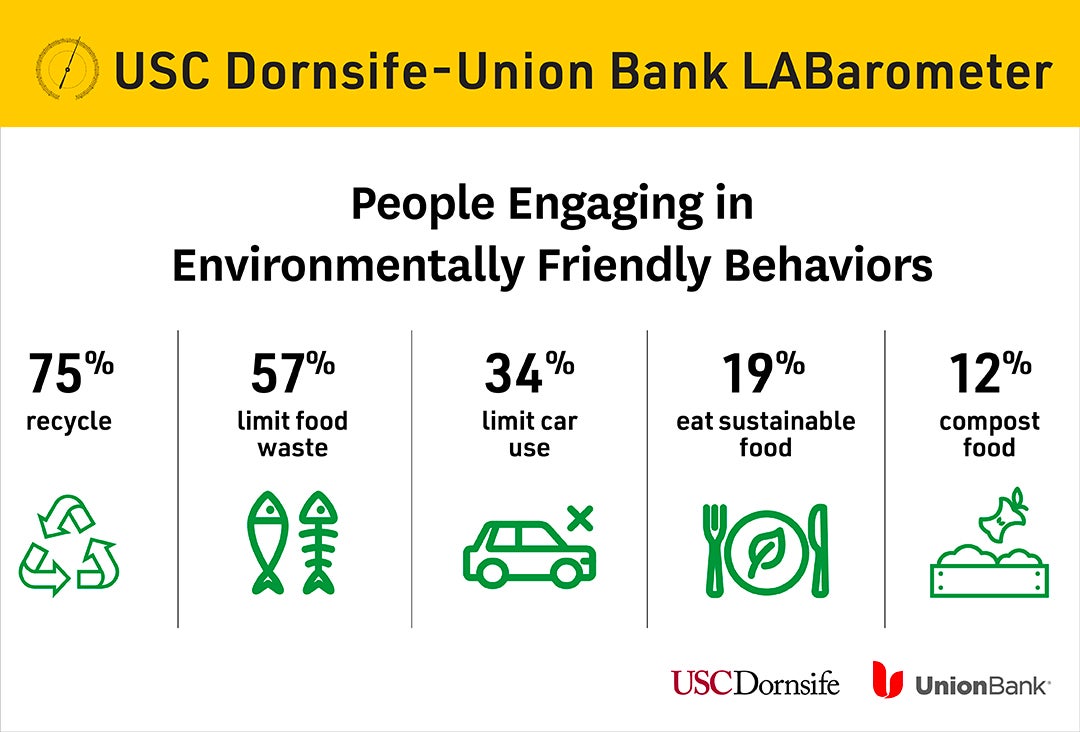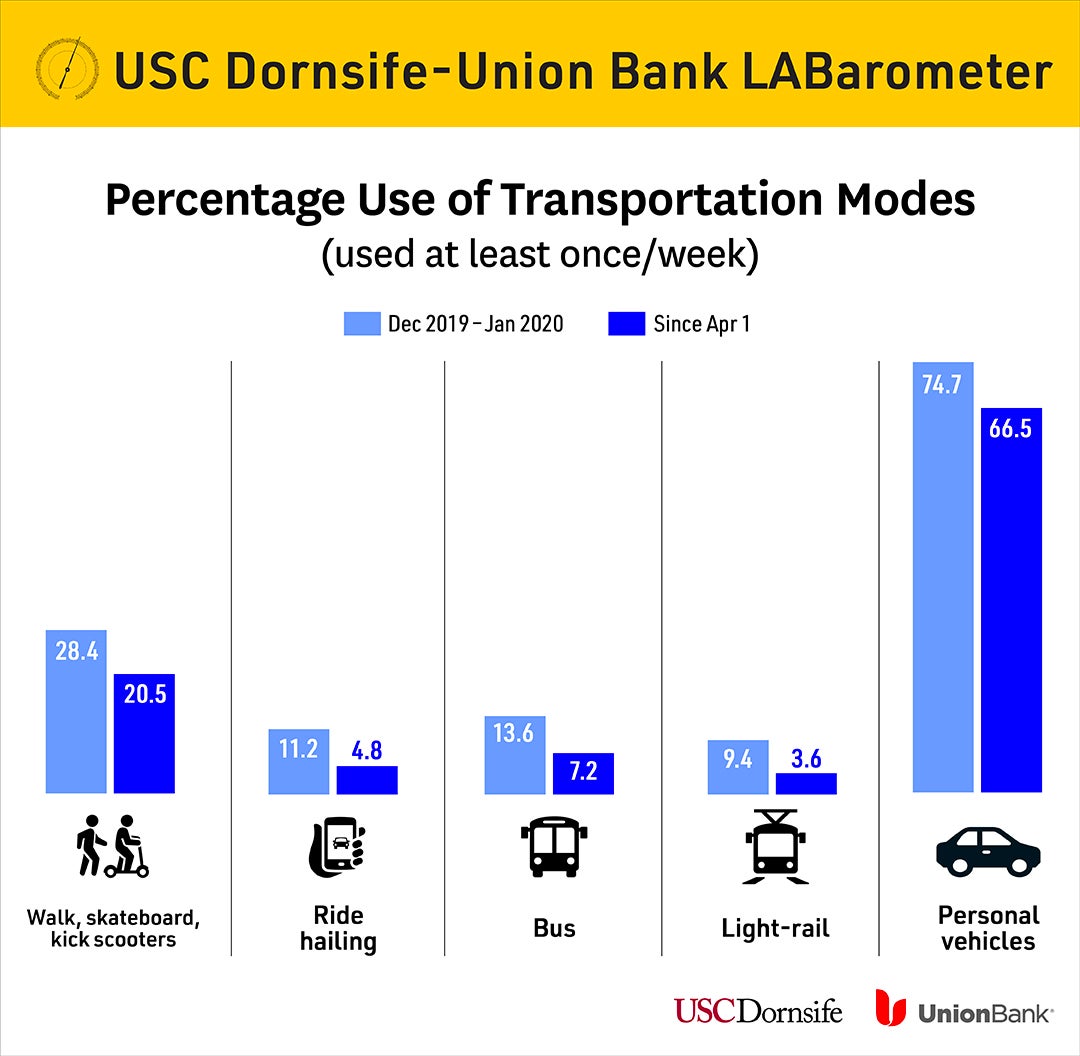
Most Angelenos say climate change is a threat, but few act accordingly and many are unaware of opportunities to fight it
A new report shows that a solid majority of Los Angeles County residents believe that climate change is caused by human activity and that it poses a threat to their well-being. And the more mindful they are of the threat, the more willing they are to adopt practices that benefit the environment. However, less than half of residents are aware of government incentives to help them adopt those practices, and a large majority are unprepared for the threat posed by climate change, including its ability to exacerbate wildfires.
The USC Dornsife-Union Bank LABarometer Sustainability and Resilience Report also found that transportation patterns have changed substantially since the COVID-19 outbreak, with residents using their personal vehicles less frequently and the use of most public transportation options down sharply.
“The majority of Angelenos want to help fight climate change, but many of them are not adopting greener practices and are unaware of the support that would allow them to do so,” said Marco Angrisani, an economist with the USC Dornsife College of Letters, Arts and Sciences’ Center for Economic and Social Research (CESR), which prepared the USC Dornsife-Union Bank LABarometer’s Sustainability and Resilience Report. “This presents a tremendous opportunity to make progress against climate change by ensuring that more people know about the options they have for leading a more sustainable life.”
Money matters
The survey also showed that income plays a major role in the degree to which people are able to adapt to climate change. Wealthier residents seem better equipped to deal with extreme hot and cold, and they report better air quality in their homes and neighborhoods.
Nearly 70% of respondents realize that climate change is a threat to their well-being and agree with the statement that climate change is mostly due to human activity. A slightly lower share, 64%, believe that their actions can make a difference in fighting climate change.
But only a minority own energy-efficient systems, such as solar panels, solar water heaters and electric vehicles. Interestingly, less than half of respondents were aware of tax credits and cash rebates for owning or leasing an electric car, installing solar power or improving home energy efficiency.
Scientists say climate change is helping to fuel the recent wildfires that have consumed thousands of homes and taken an increasing number of lives along the West Coast. But the survey found that the vast majority of L.A. County residents are not well prepared for fires or other disasters: Just 8.5% report being very or extremely prepared for a disaster, and less than a third have developed an emergency response plan.
When asked to rate the resilience of their community, wealthier residents reported being better able to withstand shocks to their neighborhoods.
Some “green” activities are more popular than others
The LABarometer survey found that Angelenos who are concerned about climate change engage in a greater number of environmentally friendly behaviors, though their commitment to those behaviors varies widely. Three out of four respondents say they recycle, making it the most popular “green” activity among the 15 different actions tracked by the survey. More than half say they limit food waste, and more than a third say they limit car use. But less than 20% said they eat sustainable food, and only 12% said they composted their food.
In addition to being concerned about a changing climate, the survey finds that nearly 1 in 3 L.A. County residents believe their drinking water is at least somewhat unsafe. About the same number feel the air in their neighborhoods is at least somewhat unsafe to breathe — and that was before the recent fires broke out and substantially lowered air quality throughout the L.A. Basin.
L.A. might have cleaner air if more people drove electric and hybrid cars, but only about 10% of residents own such vehicles. About a third of respondents say they are at least somewhat likely to buy or lease an electric car, with the percentage jumping to 41% for hybrid cars.
The most frequently cited barriers to acquiring an electric car were concerns about the cost, fear of running out of power and even maintenance costs, which are actually lower for electric vehicles compared with conventional vehicles.
Because temperatures in L.A. County have been steadily increasing for more than 125 years, it’s not surprising that Angelenos are feeling the heat: The LABarometer survey found that up to 30% of residents sometimes suffered from symptoms related to heat exposure, such as headaches, tiredness or weakness, and heavy sweating. Compounding the problem, two out of three residents say their neighborhoods don’t provide enough shade for walking on hot, sunny days.
COVID-19 and the daily commute
The survey finds that COVID-19 has fundamentally altered work and commuting patterns.
While residents still prefer their personal vehicles over other modes of transportation by a wide margin, they are using them less. During an earlier LABarometer survey that focused on transportation, conducted in December 2019 and January 2020, just prior to the COVID-pandemic hitting the United States, 75% of people reported using their personal vehicles at least once a week. But this year between April 1 and mid-July, the proportion declined to 67% of respondents, according to the most recent survey.
Use of other transportation modes also declined during the same periods. About 7% of people reported using the bus a least once a week during the most recent period, compared to nearly 14% in the prior period. Only 3.6% of respondents said they used light rail at least once a week between April 1 and mid-July, down from 9.4% in the earlier period. Use of ride-hailing services and even frequency of walking also declined.
The proportion of people working from home 4 – 5 days per week jumped to 38% in June, up from 21% in February. Nearly two-thirds of respondents said they would prefer to continue working from home at least 2 – 3 days per week, which would help reduce climate-altering emissions from transportation. But fewer than 40% said they expect to be able to continue working from home in the long term.
About the USC Dornsife-Union Bank LABarometer survey
A total of 1,421 L.A. County residents participated in the Sustainability and Resilience Survey from June 3 through July 13, 2020. Participants were recruited from LABarometer’s survey panel of 1,896 adults living in randomly selected households throughout L.A. County. The participation rate for the survey was 75%. The overall margin of sampling error is 2.6 percentage points.
LABarometer is made possible by the generous support of Union Bank through a sponsorship agreement. The agreement is funded for 10 years, with plans to expand survey participation in L.A. County over the next few years to provide a more comprehensive understanding of the region. The survey questions, topline data, and data files as well as a press room featuring this release and other information are available at https://cesr.usc.edu/labarometer/overview. The survey analysis is supported by USC Dornsife’s Public Exchange.
LABarometer is a quarterly, internet-based survey of about 1,800 randomly selected L.A. County residents, designed and administered by the Center for Economic and Social Research (CESR) at the USC Dornsife College of Letters, Arts and Sciences. The survey monitors social conditions in L.A., with a focus on four key issues: livability, mobility, sustainability and resilience, and affordability and prosperity. By following the same residents over time, LABarometer aims to capture trends and shifts in residents’ attitudes and circumstances, allowing decision-makers in the public and private sectors to better understand the evolving lives and needs of L.A. County residents.

